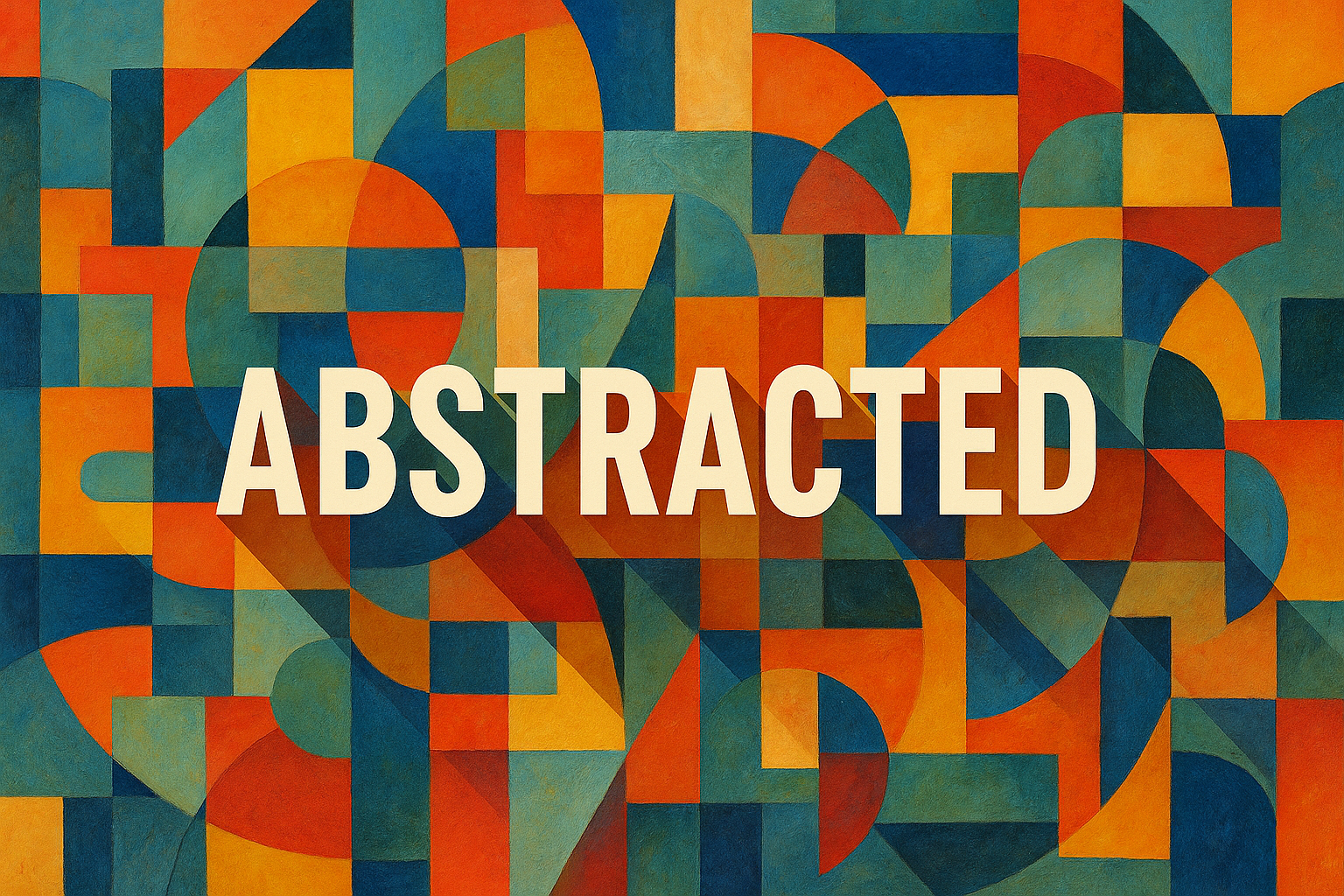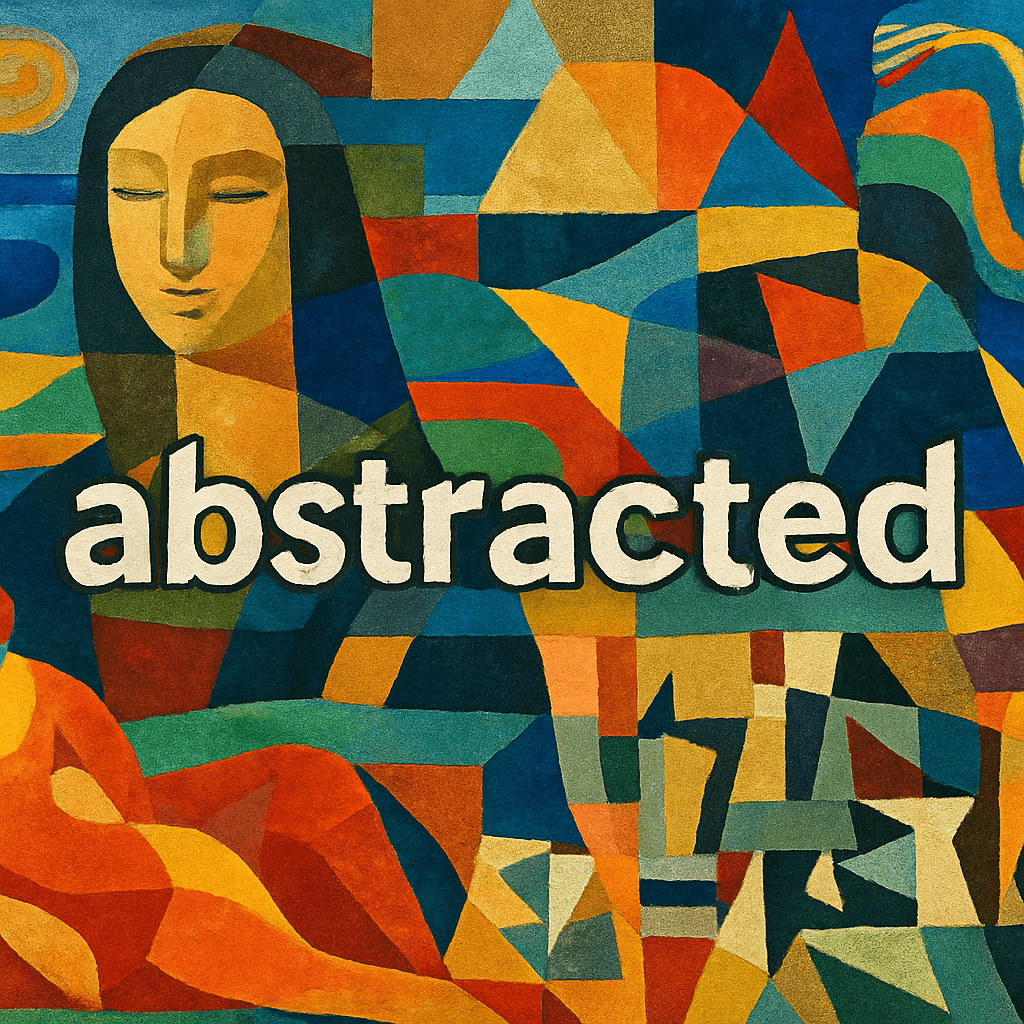
Abstracted
The art style known as Abstracted is characterized by its departure from realistic representation, focusing instead on the use of shapes, colors, and forms to convey meaning or evoke emotions. In this style, recognizable objects and figures are often simplified, distorted, or completely unrecognizable, allowing the viewer to interpret the artwork in a personal and subjective manner. The compositions may feature bold, vibrant colors or subtle, muted tones, depending on the artist’s intent. Lines and shapes can be geometric or organic, creating a sense of movement or stillness. The overall effect is often one of spontaneity and freedom, encouraging viewers to engage with the artwork on an intuitive level. Abstracted art can range from minimalistic to highly complex, with layers of texture and depth that invite closer inspection.
AOI thinking about Abstracted [+_~]-/
Overview and Quickfacts
Abstracted art is a style that emphasizes the simplification and alteration of forms, often distilling subjects to their essential shapes, colors, and lines. This approach moves away from realistic representation, focusing instead on conveying emotions, ideas, or concepts through abstraction. Artists working in this style often manipulate elements such as color, form, and composition to create works that evoke a sense of movement, rhythm, or harmony. Abstracted art can be seen as a bridge between representational art and pure abstraction, allowing for a degree of recognizable imagery while still prioritizing the expressive potential of abstract elements. This style has been influential in various art movements, including Cubism, Futurism, and Abstract Expressionism, and continues to inspire contemporary artists seeking to explore the boundaries of visual representation.
Can understand it also, as:
Preoccupied, Distracted, Absentminded, Engrossed
Categorize it as:
Impressionism, Modernism
.: Dreaming :.
holds a HAIKU for the art style
:. Thought is power .:
Detailed Description
Title: Exploring the Enigmatic World of Abstracted Art In the vast and diverse landscape of art, few styles captivate the imagination quite like Abstracted art. This genre, characterized by its departure from realistic representation, invites viewers to engage with art on a more intuitive and emotional level. Abstracted art, often synonymous with abstract art, is a celebration of color, form, and line, unbound by the constraints of depicting the physical world. It is a style that challenges both the artist and the audience to explore the depths of creativity and perception. The Origins of Abstracted Art The roots of Abstracted art can be traced back to the late 19th and early 20th centuries, a period marked by rapid industrialization and significant social change. Artists began to question traditional artistic conventions and sought new ways to express the complexities of modern life. This quest for innovation led to the birth of various avant-garde movements, with Abstracted art emerging as a prominent force. One of the earliest pioneers of abstract art was Wassily Kandinsky, a Russian painter and art theorist. Kandinsky believed that art should transcend the material world and evoke spiritual and emotional responses. His groundbreaking work, “Composition VII” (1913), is a vibrant explosion of color and form, devoid of any recognizable subject matter. Kandinsky’s theories on the spiritual nature of art laid the foundation for future abstract artists. The Evolution of Abstracted Art As the 20th century progressed, Abstracted art evolved into a diverse and multifaceted genre. Artists began to experiment with different techniques and materials, pushing the boundaries of what art could be. The movement gave rise to several sub-genres, each with its own unique characteristics and philosophies. One of the most influential sub-genres of Abstracted art is Abstract Expressionism, which emerged in the United States in the 1940s and 1950s. This movement emphasized spontaneous, gestural brushstrokes and the use of color to convey emotion. Jackson Pollock, a leading figure in Abstract Expressionism, became famous for his “drip paintings,” such as “No. 5, 1948.” Pollock’s innovative technique involved dripping and splattering paint onto a canvas laid on the ground, creating dynamic and chaotic compositions. Another notable artist associated with Abstract Expressionism is Mark Rothko, known for his large-scale color field paintings. Rothko’s works, such as “No. 61 (Rust and Blue)” (1953), feature soft-edged rectangles of color that seem to float on the canvas. His paintings are meditative and contemplative, inviting viewers to immerse themselves in the subtle interplay of hues. The Impact of Abstracted Art Abstracted art has had a profound impact on the art world and continues to influence contemporary artists. Its emphasis on individual expression and emotional resonance has inspired countless creators to explore new artistic possibilities. The movement has also challenged traditional notions of beauty and representation, encouraging audiences to engage with art in a more personal and subjective manner. One of the most significant contributions of Abstracted art is its ability to transcend cultural and linguistic barriers. By focusing on universal elements such as color, form, and texture, abstract art can communicate emotions and ideas that resonate with people from diverse backgrounds. This universality has made Abstracted art a powerful tool for cross-cultural dialogue and understanding. Famous Abstracted Artworks and Artists In addition to Kandinsky, Pollock, and Rothko, several other artists have made significant contributions to the Abstracted art movement. Piet Mondrian, a Dutch painter, is renowned for his geometric compositions featuring primary colors and black lines. His work “Composition with Red, Blue, and Yellow” (1930) exemplifies his pursuit of harmony and balance through abstraction. Another influential figure is Kazimir Malevich, a Russian avant-garde artist known for his development of Suprematism, a movement focused on basic geometric forms. Malevich’s iconic painting “Black Square” (1915) is a radical departure from traditional art, representing a new beginning in the exploration of pure abstraction. Conclusion Abstracted art is a testament to the boundless creativity of the human spirit. It challenges us to look beyond the surface and engage with art on a deeper, more intuitive level. Through its rich history and diverse expressions, Abstracted art continues to inspire and provoke, inviting us to explore the infinite possibilities of artistic expression. Whether through the bold gestures of Abstract Expressionism or the serene compositions of color field painting, Abstracted art remains a vital and dynamic force in the world of art.
.. beep, beep, beep ..
<START OF TRANSMISSION>
1. Abstracted is a term often used in art and design to describe a style that distills subjects to their essential forms. 2. In the context of software development, abstraction refers to the process of hiding complex implementation details to simplify usage. 3. Abstracted concepts are prevalent in mathematics, where they help in generalizing problems and solutions. 4. In literature, abstracted themes often explore complex ideas through symbolic or metaphorical language. 5. Abstracted art movements include Cubism, Abstract Expressionism, and Minimalism. 6. The process of abstraction in programming often involves creating classes and interfaces. 7. Abstracted thinking is a cognitive process that allows individuals to focus on the bigger picture rather than specific details. 8. In music, abstracted compositions might focus on sound textures and patterns rather than traditional melodies. 9. Abstracted data models in databases help in organizing information without focusing on the physical storage details. 10. Abstracted user interfaces aim to provide a seamless experience by hiding complex backend processes. 11. Abstracted reasoning is a key component of problem-solving and critical thinking. 12. In psychology, abstraction is a mental process where specific details are ignored to focus on general concepts. 13. Abstracted landscapes in art often emphasize color and form over realistic representation. 14. The concept of abstraction is fundamental in object-oriented programming. 15. Abstracted algorithms are designed to solve a wide range of problems by focusing on the underlying logic. 16. In philosophy, abstracted ideas often deal with concepts like existence, knowledge, and truth. 17. Abstracted sculptures may use geometric shapes to represent complex ideas or emotions. 18. Abstracted language in poetry can evoke emotions and imagery without direct description. 19. Abstracted economic models simplify real-world complexities to predict trends and behaviors. 20. Abstracted scientific theories often use models and simulations to understand phenomena without direct observation.
<EOF>
.. robbel bob
Visual Examples from our image gallery
Coming soon, we are so slow .. might never come
Artists, Paintings, and more
(be aware, can be highly speculative)
Artists (be aware, speculation possible):
1. Wassily Kandinsky (1866-1944) 2. Piet Mondrian (1872-1944) 3. Paul Klee (1879-1940) 4. Lyubov Popova (1889-1924) 5. Kazimir Malevich (1879-1935) 6. Alexander Rodchenko (1891-1956) 7. David Smith (1906-1965) 8. Jean Arp (1886-1966) 9. Max Ernst (1891-1976) 10. Joan Miro (1893-1983) 11. Pietro Annigoni (1910-1988) 12. Jackson Pollock (1912-1956) 13. Mark Rothko (1903-1970) 14. Clyfford Still (1904-1980) 15. Barnett Newman (1905-1970) 16. Adolph Gottlieb (1903-1974) 17. Helen Frankenthaler (1928-2011) 18. Robert Motherwell (1915-1991) 19. Kenneth Noland (1924-2010) 20. Jules Olitski (1922-2007) 21. Brice Marden (1938- ) 22. Chuck Close (1940- ) 23. Richard Diebenkorn (1922-1993) 24. Philip Guston (1913-1980) 25. Cy Twombly (1928-2011) 26. Frank Stella (1936- ) 27. Robert Rauschenberg (1925-2008) 28. Jasper Johns (1930- ) 29. Ellsworth Kelly (1923-2015) 30. Agnes Martin (1912-2004)
Artworks (be aware, speculation possible)
1. “Composition VIII” by Wassily Kandinsky, 1923 2. “No. 5, 1948” by Jackson Pollock, 1948 3. “Black Square” by Kazimir Malevich, 1915 4. “The Persistence of Memory” by Salvador Dalí, 1931 5. “Woman I” by Willem de Kooning, 1950-1952 6. “Broadway Boogie Woogie” by Piet Mondrian, 1942-1943 7. “Convergence” by Jackson Pollock, 1952 8. “Blue Poles” by Jackson Pollock, 1952 9. “The Red Studio” by Henri Matisse, 1911 10. “Improvisation 28 (second version)” by Wassily Kandinsky, 1912
Epoch
The time period of the art style Abstracted is the early 20th century.
AI ART RESSOURCES (AKA, well Tools)
Helping tools -> predefined search links on other pages:











